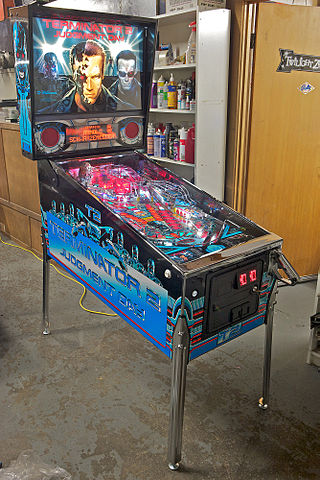
Pinball games are a family of games in which a ball is propelled into a specially designed table where it bounces off various obstacles, scoring points either en route or when it comes to rest. Historically the board was studded with nails called 'pins' and had hollows or pockets which scored points if the ball came to rest in them. Today, pinball is most commonly an arcade game in which the ball is fired into a specially designed cabinet known as a pinball machine, hitting various lights, bumpers, ramps, and other targets depending on its design. The game's object is generally to score as many points as possible by hitting these targets and making various shots with flippers before the ball is lost. Most pinball machines use one ball per turn, and the game ends when the ball(s) from the last turn are lost. The biggest pinball machine manufacturers historically include Bally Manufacturing, Gottlieb, Williams Electronics and Stern Pinball.
A glossary of terms, commonly used in discussing pinball machines.

Medieval Madness is a Williams pinball machine released in June 1997. Designed by Brian Eddy and programmed by Lyman Sheats, it had a production run of 4,016 units. As of April 3, 2022, the Pinside pinball community lists it as the #2 highest-ranked pinball machine ; many adherents consider it the greatest of all time.
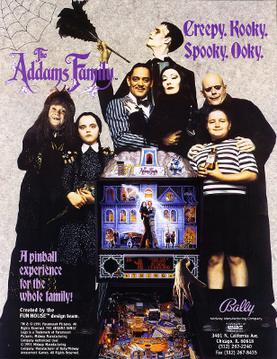
The Addams Family is a pinball machine released in March 1992. It was designed by Pat Lawlor and Larry DeMar and released by Midway. It was based on the 1991 film of the same name, and features custom speech by the stars of the film, Anjelica Huston and Raul Julia. It is the best-selling solid state pinball machine of all time with 20,270 units sold.
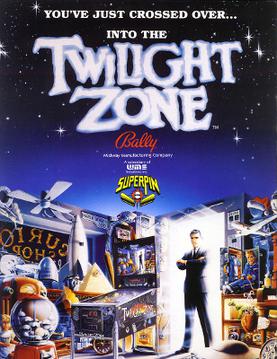
Twilight Zone is a widebody pinball machine, designed by Pat Lawlor and based on the TV series of the same name. It was first released in 1993 by Midway. This game is part of WMS' SuperPin line of widebody games alongside Star Trek: The Next Generation and Indiana Jones: The Pinball Adventure.

Cirqus Voltaire is a 1997 pinball game, designed by John Popadiuk and released by Williams Electronics Games. The theme involves the player performing many different marvels in order to join the circus. Some of the game's distinctive features include a neon light running along the right-hand ramp, a pop bumper that rises up from the middle of the playfield at certain times, and a magnet at the top of the left ramp that can catch balls and divert them into the locks. The most notable feature is the Ringmaster, a head that rises at certain times and taunts the player.

Attack from Mars is a 1995 pinball game designed by Brian Eddy, and released by Midway.

Terminator 2: Judgment Day is a 1991 pinball machine designed by Steve Ritchie and released by Williams Electronics. It is based on the motion picture of the same name.
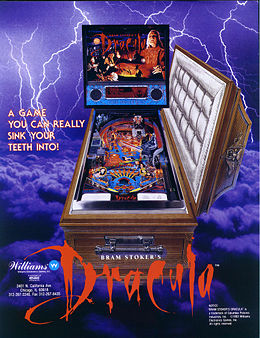
Bram Stoker's Dracula is a 1993 pinball machine released by Williams. It is based on the 1992 film of the same name.

The Flintstones is a pinball game released by Williams in 1994 and based on the movie of the same name which is based on 1960–1966 animated television series of the same name. This machine is not to be confused with another pinball machine, a redemption game, based on the TV series and also released in 1994, manufactured by Innovative Concepts in Entertainment (ICE).

The Party Zone is a crossover solid-state pinball machine released in 1991 by Midway designed by Dennis Nordman and programmed by Jim Strompolis. It is in a single playfield format and collaborates characters from previous pinball machines. It is the second pinball machine released after the Bally-Midway division was sold, yet still operated under the "Bally" name.
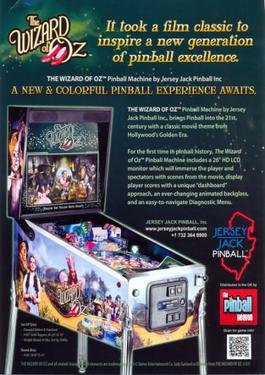
The Wizard of Oz is a Jersey Jack Pinball, Inc. pinball machine designed by Joe Balcer and released in April 2013. It is the first US pinball machine with an LCD in the back box as well as the first one to have color on the monitor produced in the US since the Pinball 2000 games. Although it is not the first pinball machine with a LCD worldwide because MarsaPlay in Spain manufactured a remake of Inder's original Canasta titled New Canasta, with an LCD screen in the backbox in 2010.

Harley-Davidson is a Sega Pinball pinball machine released in September 1999 and was the last machine released by this company. It was designed by Jon Borg and Lonnie D. Ropp.
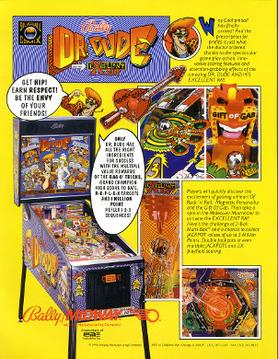
Dr. Dude and His Excellent Ray is a pinball machine designed by Dennis Nordman and released in 1990 by Midway. The theme of the game revolves around gaining coolness.

Spirit of 76 is a pinball game designed by Ed Krynski and Wayne Neyens and released in 1975 by Gottlieb. The pinball machine should not be confused with the pinball machine The Spirit of '76 by Mirco Games, Inc.
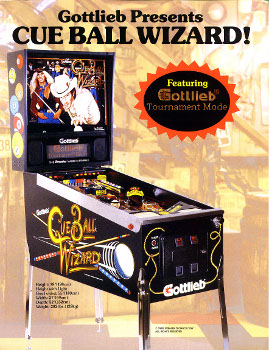
Cue Ball Wizard is a pinball machine designed by Jon Norris and released in December 18 1992 by Gottlieb. It features a cue sports theme and was advertised with the slogan "Gottlieb Presents CUE BALL WIZARD!".

Lights...Camera...Action! is a pinball machine designed by Jon Norris and released by Gottlieb in 1989. The game features a movie making show business theme.

Cyclone is a pinball machine released by Williams Electronics in 1988. It features an amusement park theme, Coney Island, and was advertised with the slogan "It'll blow you away!". Ronald Reagan and Nancy Reagan both appear in the backglass shown riding the rollercoaster.
The Hobbit is a pinball machine designed by Joe Balcer and released by Jersey Jack Pinball in March 2016. It is based on The Hobbit films of the same name which is based on J. R. R. Tolkien’s 1937 novel The Hobbit.
WWF Royal Rumble is a pinball machine designed by Tim Seckel and released by Data East in April 1994.


















